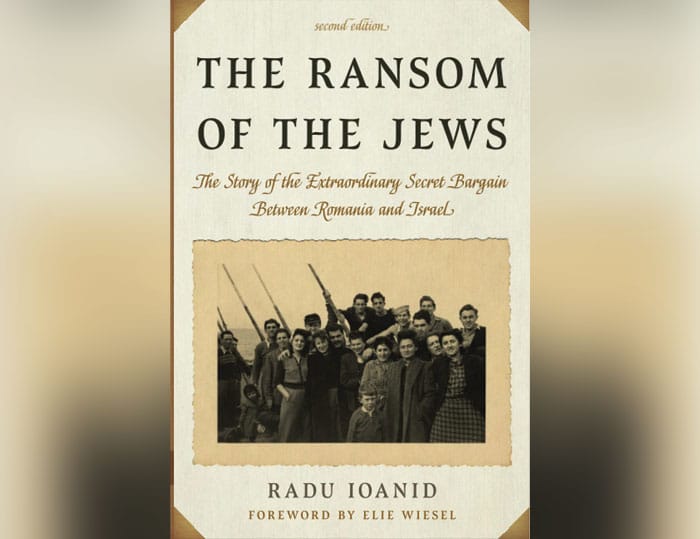
Readers Beware: The author of the book, “The Ransom of the Jews: The Story of the Extraordinary Secret Bargain between Romania and Israel,” Radu Ioanid, now Romania’s Ambassador to Israel, was a colleague of mine for almost a decade at the United States Holocaust Museum some thirty years ago, and has been a friend ever since. I was technically his boss, but it would be an exaggeration to suggest that Ioanid was subordinate to anyone. So, I am neither dispassionate about the man nor the subject. An informed reader can make the appropriate judgments about this review.
In 1944, during the most intense final period of the murder of the Jews, there was an advertisement in major newspapers: “Jews for Sale.” There were no takers; after all, what was one going to do with these Jews and who would pay for their ransom?
Let us understand the context: Romanian ruler Marshal Ion Antonescu, the Romanian dictator who had been allied with Nazi Germany, had come to the conclusion, widely shared in 1944 after Stalingrad and the Soviet advances in the East, even before D-Day, that Hitler’s Germany was going to lose the war. Suddenly, after Romania had most actively participated in the murder of its own Jews and willingly assisted Germany in the murder of non-Romanian Jews, living Jews might be more valuable than dead Jews, more profitable to him, more advantageous to his nation.
Antonescu’s plan was unsuccessful for wont of a buyer—no country quite wanted the Jews—and also because of wartime conditions money could not be exchanged with the enemy. Fortunately for the Jews of the “old Romania”—not the territories that Romania was given because of its alliance with Germany—this plan to sell the Jews was a lifeline as the killing was postponed and soon, though certainly not soon enough, the war ended and a sizable population of Jews remained alive in Romania.
That story has been well-told twice by Ioanid, first in his own masterful book “The Holocaust in Romania: The Destruction of Jews and Gypsies Under the Antonescu Regime, 1940-1944” and later in the work that he undertook as part of the Wiesel Commission, a truthful international study of the record of Romania toward its own Jewish community during the Holocaust chaired by Wiesel and with the participation of a committee of some of the world’s leading scholars both in Romania and elsewhere. Because of the Nobel Prize-winning author’s stature and the reputation of his fellow panelists, as well as the quality of Ioanid’s work, the Commission prevailed against political pressure from Romanian authorities.
Romanian Jews were the largest national community in Israel. Howa that happened is a fascinating story with plots and subplots, corruption, intrigue, daring, politics, and, above all, money.
In “The Ransom of the Jews,” Ioanid gets to complete the story of “Jews for Sale,” this time most completely as prior to the great Aliyah of Soviet Jews, Romanian Jews were the largest national community in Israel. How that happened is a fascinating story with plots and subplots, corruption, intrigue, daring, politics, and, above all, money.
The basic outlines of the story are easy to tell but the devil is in its fascinating details.
After World War II, Romania was in desperate need to buttress its floundering agricultural sector, including even sperm for calves, and a Jewish middleman living abroad proved useful. He would supply what was needed, and the cost would include exit permits for a modest number of Jewish families. There were handsome profits for the middleman—genuine gains for Romania’s economy and a limited number of Jews were set free to live a life of their choosing in Israel or in the Western world.
Later as industrialization was gaining some steam in the post-war Romanian economy, this Jew again proved useful as machinery replaced chickens and sperm as the desired import. Again, money was exchanged, profits were significant, and an additional but limited number of Jews were allowed to leave.
Enter the Israelis, and most especially a most skilled intelligence operative Shaike Dan. They were anxious to eliminate the Jewish middleman, more anxious still to get the Jews out and not unhappy to remove some levels of corruption even as Jews benefitted from that corruption, which proved indispensable to their freedom.
Romanian ruler Nicolae Ceausescu was a key player. He was an anomaly: tyrannical at home, he tried to distance Romania from the Soviet orbit and to chart some sort of independent policy toward the West. He did not break off diplomatic relations with Israel after the Six Day War. Because of that attitude and his apparent dissent within the Communist Soviet bloc, he became a darling of the West, which learned to tolerate his corruption and his tyrannical tendencies as long as he charted a course somewhat independent of the Warsaw bloc.
Ceausescu discovered that Romania had two unexpected sources of foreign currency: Germany and Israel. West Germany was willing to ransom ethnic Germans from Romania and Israel was willing not only to absorb Romanian Jews but also to pay for their release on a sliding scale depending on their age and training. Children and retired Jews were to be released for free, and Romania was reimbursed for the education and training of Romanian Jews of working age. The Romanian ruler would skim vital sums of money off the top both to support himself in style and to enrich himself over time.
The Chief Rabbi of Romania, one of the most fascinating characters in Eastern Europe, was indispensable to this operation. Rabbi Moshe Rosen lived in style; in synagogue and on official occasions he wore a long purple robe with a Jewish star dangling from his neck slightly yet noticeably larger than the cross worn by the Cardinal. He was sent to the West to advance Romania’s agenda, most especially its desire to receive Most Favored Nation Status for his country and met with Jewish leadership and with Congressional leadership. The trade off was clear. Support the State, even the tyrannical state, and that state will continue doing business with Israel. However unpleasant the tradeoff, however compromised his role as shtadlan, the traditional Jewish intercessor, Rosen had two unparalleled achievements: Romanian Jews were able to move to Israel in record number, and synagogues and old age homes, even Jewish educational and cultural institutions, remained viable for an ever-diminishing Jewish community. It wasn’t pretty, it wasn’t morally pure, but it worked.
As a Romanian, Ioanid is most uncomfortable with the moral compromises that were made, with the corruption of Romanian leadership and with the way that Ceausescu was able to use the Jews to prolong his rule. As a storyteller, he is fascinated by the story—who would not be?—as will be his readers. As a historian, he divides the book in two, narrating the story in the first part and presenting the original documents that substantiate his case in the other, documents now available because of the freedom that Romania has enjoyed in the post-Communist era.
It is important to understand that Jews are much better off in a free society, but if forced to live under tyranny, they are fortunate if they are perceived to be of use to the regime, and most fortunate if they are wanted elsewhere. When Jews were offered for sale this time, Israel and American Jewish organizations were willing to pay the price. Both dictators Antonescu and Ceausescu found that living Jews were more valuable than dead Jews, but only Ceausescu was able to actually sell them.
Michael Berenbaum is director of the Sigi Ziering Institute and a professor of Jewish Studies at American Jewish University.























 More news and opinions than at a Shabbat dinner, right in your inbox.
More news and opinions than at a Shabbat dinner, right in your inbox.